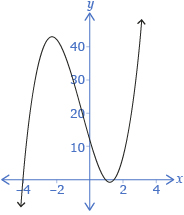You should have concluded that x = 7, 4, 2, and −1 are solutions to the equation. The whooping crane population will be 45 after 2, 4, and 7 years. Since Isabel is looking forward and not backward, −1 is not used.
Many steps were used to solve this problem. Here is a summary of how to solve polynomial equations.
| Example | Mathematical Justification |
| Solve 2x3 + 3x2 − 17x + 7 = −5. | Your teacher asked you to solve this. |
| 2x3 + 3x2 − 17x + 12 = 0 | Add 5 to both sides to create an equivalent equation where the zero-product property can be used. |
| The factors of 12 are ±1, ±2, ±3, ±4, ±6, ±12. | The integral zero theorem says to check factors of the constant term using the factor theorem. |
Graph f(x) = 2x3 + 3x2 − 17x + 12:
|
Rather than testing all of the factors of 12, graph the function and look for x-intercepts, because x-intercepts correspond to factors. |
Test for a factor of x + 4.
|
It appears that x = −4 is an x-intercept. This would correspond to a factor of x − (−4), which is normally written as x + 4. The factor theorem says that x − a is a factor of P(x) if P(a) = 0. |
Perform (2x3 + 3x2 − 17x + 12) ÷ (x + 4).
2x3 + 3x2 − 17x + 12 = (x + 4)(2x2 − 5x + 3) |
x + 4 is a factor, so divide by this factor to determine another factor.
This example uses synthetic division, but you can use long division (from Lesson 2) if you prefer. |
2x2 − 5x + 3 = (2x − 3)(x − 1) 2x3 + 3x2 − 17x + 12 = (x + 4)(2x − 3)(x − 1) |
The quadratic can also be factored. |
| (x + 4)(2x − 3)(x − 1) = 0 | Rewrite the equation using this equivalent factored form so the zero-product property can be used. |
x + 4 = 0
2x − 3 = 0 x − 1 = 0 |
Apply the zero-product property. |
| Solve. These are the solutions to the original equation.
|


